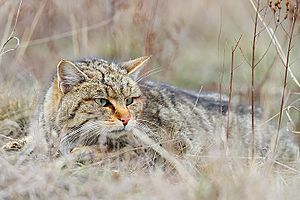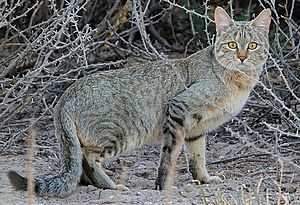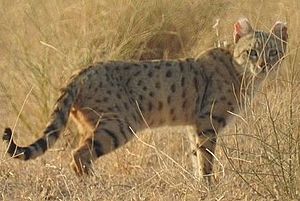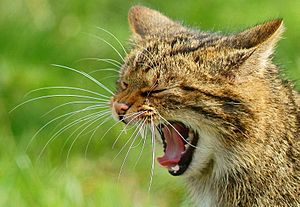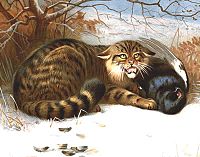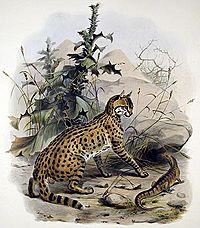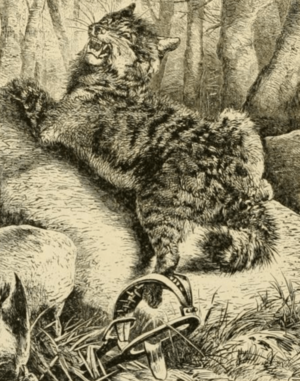Wildcat facts for kids
Quick facts for kids Wildcat |
|
|---|---|
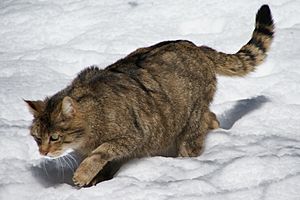 |
|
| European wildcat (Felis silvestris) | |
 |
|
| African wildcat (Felis lybica) | |
| Conservation status | |
| Scientific classification | |
| Kingdom: | Animalia |
| Phylum: | Chordata |
| Class: | Mammalia |
| Order: | Carnivora |
| Suborder: | Feliformia |
| Family: | Felidae |
| Subfamily: | Felinae |
| Genus: | Felis |
| Bionomial name | |
| Felis silvestris Schreber, 1777 |
|
| Felis lybica Forster, 1780 |
|
 |
|
| Distribution of the wildcat species complex | |
Wildcats are a group of small, wild felines. They include two main species: the European wildcat (Felis silvestris) and the African wildcat (F. lybica). These amazing cats look a bit like domestic cats but are wild and strong.
The European wildcat lives in forests across Europe, Anatolia, and the Caucasus mountains. The African wildcat prefers dry areas and steppes. You can find them in Africa, the Arabian Peninsula, Central Asia, and even parts of India and China.
Wildcats are different from each other in their fur, tail, and size. European wildcats have long fur and a bushy tail with a round tip. African wildcats are smaller with short, sandy-gray fur and a tail that gets thinner at the end. Some African wildcats, like the Asiatic wildcat (F. lybica ornata), even have spots!
All cats, including wildcats, share a common ancestor from millions of years ago. The European wildcat developed a long time ago, about 866,000 to 478,000 years ago. Its ancestor was an older cat called Felis lunensis. The European and African wildcat groups likely split about 173,000 years ago.
Wildcats are listed as "Least Concern" by the IUCN Red List. This means their global population is stable, with over 20,000 adult cats. However, in some places, they face threats. They can breed with domestic cats, which can change their genes. They can also catch diseases from domestic cats. Sometimes, wildcats are hit by cars or hunted by people.
African wildcats and humans started living closer together during the Neolithic Revolution. This was when people began farming and building settlements. Rodents were attracted to grain stores, and wildcats came to hunt the rodents. This close relationship eventually led to the domestication of the domestic cat, which is a direct descendant of the African wildcat. Wildcats were even honored in ancient Egypt. The European wildcat has also appeared in old stories and books.
Contents
Wildcat Family Tree
The scientific name Felis (catus) silvestris was first used in 1777 by Johann Christian Daniel von Schreber. He described the European wildcat based on earlier notes from naturalists. Later, in 1780, Georg Forster named the African wildcat Felis lybica. He described one from Gafsa in North Africa.
Over the years, many scientists studied wildcats from Europe, Africa, and Asia. In the 1940s, a scientist named Reginald Innes Pocock looked at many wildcat skins and skulls. He identified different groups of wildcats:
- Forest wildcats (silvestris group): These are the European wildcats.
- Steppe wildcats (ornata-caudata group): These are smaller and have lighter fur than forest wildcats. Their tails are longer and more pointed. Scientists believe domestic cats came from this group.
- Bush wildcats (ornata-lybica group): These have paler fur and clear spots and stripes.
In 2017, a group of cat experts updated the classification of the cat family. They recognized these main types of wildcats:
| Species and subspecies | What they look like | Image |
|---|---|---|
| European wildcat (F. silvestris) | This cat has dark grey fur with clear stripes on its sides. Its tail is bushy with a rounded black tip. | |
| Caucasian wildcat (F. s. caucasica) | This wildcat is light grey. It has clear patterns on its head and back, with faint stripes and spots on its sides. Its tail has three clear black rings. | |
| African wildcat (F. lybica) | This cat has pale, light-grey fur, sometimes with a reddish tint on its back. Its pointed tail is about two-thirds the length of its body. | |
| Southern African wildcat (F. l. cafra) | This wildcat looks very similar to the main African wildcat. Some have slightly longer skulls. | |
| Asiatic wildcat (F. l. ornata) | This wildcat has dark spots on light, yellowish-grey fur. |
How Wildcats Evolved
Wildcats belong to the Felidae family, which includes all cats. This family shared a common ancestor about 10 to 15 million years ago. Different Felis species, like the wildcat, started to develop separately around 6 to 7 million years ago. The European wildcat became its own species about 1.09 to 1.4 million years ago.
The direct ancestor of the European wildcat was Felis lunensis. This ancient cat lived in Europe during the Pliocene period. Fossils show that Felis lunensis slowly changed into Felis silvestris around 340,000 to 325,000 years ago.
Differences in their skulls suggest that wildcats likely moved from Europe to the Middle East during the Late Pleistocene ice age. This led to the development of the steppe wildcat. Genetic studies show that the African wildcat group likely split from the European wildcat group about 173,000 years ago.
Wildcat Characteristics
Wildcats have pointed ears that are medium in size and wide at the bottom. Their whiskers are white and can be 5 to 8 centimeters (2 to 3 inches) long on their snout. They also have whiskers on their paws, about 3 to 4 centimeters (1 to 1.5 inches) long.
Their eyes are large with vertical pupils and yellowish-green irises. They have 6 to 8 eyelashes on each side, about 5 to 6 centimeters (2 to 2.4 inches) long.
The European wildcat has a larger skull than a domestic cat. Its skull is also more round than that of a jungle cat or leopard cat. Its teeth are smaller and weaker compared to a jungle cat's.
Both wildcat species are bigger than domestic cats. European wildcats have longer legs and a stronger body. Their tail is long, usually more than half the length of their body. Wildcats in colder, northern areas like Mongolia and Siberia tend to be the largest. Male wildcats are 43 to 91 centimeters (17 to 36 inches) long from head to body. Their tails are 23 to 40 centimeters (9 to 16 inches) long, and they usually weigh 5 to 8 kilograms (11 to 18 pounds). Females are a bit smaller, measuring 40 to 77 centimeters (16 to 30 inches) long with tails 18 to 35 centimeters (7 to 14 inches) long. They weigh 3 to 5 kilograms (7 to 11 pounds).
Where Wildcats Live
The European wildcat lives in forests in Europe, Turkey, and the Caucasus. In Spain, they can be found from sea level up to 2,250 meters (7,380 feet) in the Pyrenees mountains. From the late 1600s to the mid-1900s, their habitat in Europe became broken up because of a lot of hunting. They might be gone from the Czech Republic and are thought to be gone from Austria. However, some wildcats from Italy are now moving into Austria. They have never lived in Fennoscandia or Estonia. Sicily is the only island in the Mediterranean Sea where wildcats naturally live.
The African wildcat lives in many different places, but not in rainforests. They are found in the savannahs of Africa, from the Atlantic coast to the Horn of Africa, up to 3,000 meters (9,800 feet) high. Small groups live in the Sahara and Nubian Deserts, the Karoo region, and the Kalahari and Namib Deserts. They also live around the Arabian Peninsula and further east into Central Asia, Xinjiang, southern Mongolia, and dry parts of India.
Wildcat Behavior and Lifestyle
Both wildcat species are mostly active at night and live alone. They only come together to breed or when females have kittens. The size of their home areas depends on the land, how much food is available, and the age of the cats. Male and female home ranges can overlap, but each cat has a main area they keep to themselves. Females tend to stay in one place more than males, especially when raising kittens, because they need a special hunting area. Wildcats usually spend the day resting in a hollow tree, a crack in a rock, or in thick bushes.
They also hide in abandoned burrows made by other animals, like red foxes or European badgers in Europe. In Africa, they might use burrows of fennec foxes.
If a wildcat feels threatened, it will usually run into a burrow instead of climbing a tree. If it chooses a tree hollow, it picks one close to the ground. Dens in rocks or burrows are lined with dry grass and bird feathers. Tree hollows usually have enough sawdust, so they don't need extra lining. If a den gets too many fleas, the wildcat will move to a new one. In winter, when there's a lot of snow, European wildcats stay in their dens until they can travel easily again.
Wildcats mark their territory by spraying urine on trees, plants, and rocks. They also leave their droppings in noticeable places and use scent glands in their paws. They scratch trees to leave visual marks too.
Hunting and Prey
Wildcats use their excellent sight and hearing to hunt. They wait quietly for prey, then pounce with a few quick leaps that can cover three meters (about 10 feet). If they hunt near water, they might wait on trees hanging over the water. For small prey, they grab it with their claws and bite its neck. For larger prey, they jump on its back and try to bite the neck or a main artery. If the prey escapes, the wildcat usually doesn't chase it for long.
European wildcats mainly hunt small mammals like European rabbits and rodents. They also eat dormice, hares, nutria, and birds, especially ducks, waterfowl, galliformes, pigeons, and small songbirds. They can even eat large bone pieces. While they might kill insectivores like moles and shrews, they rarely eat them. If they live near people, they might hunt poultry. In the wild, they eat up to 600 grams (1.3 pounds) of food every day.
African wildcats mostly eat mice and rats. They also hunt birds, small reptiles, and invertebrates like insects.
Wildcat Reproduction and Life Cycle
Female wildcats have two breeding seasons: one from December to February and another from May to July. During the mating season, male wildcats fight fiercely. Sometimes, several males might gather around one female. There are even cases where a male and female wildcat stay together for a short time. Kittens are usually born between April and May, and sometimes up to August. A litter can have 1 to 7 kittens.
Kittens are born with their eyes closed and a soft, fuzzy coat. They weigh 65 to 163 grams (2.3 to 5.7 ounces) at birth. Kittens weighing less than 90 grams (3.2 ounces) usually don't survive. Their paw pads are pink at birth but turn black around three months old. Their eyes are blue at birth and change to amber after five months. Their eyes open after 9 to 12 days, and their first teeth appear after 14 to 30 days. Their baby teeth are replaced by adult teeth when they are 160 to 240 days old.
Kittens start hunting with their mother at 60 days old and begin to move around on their own after 140 to 150 days. They drink milk for 3 to 4 months, but they start eating meat as early as 1.5 months old. They can have their own kittens when they are about 300 days old. African wildcat kittens grow much faster than European wildcat kittens during their first two weeks. Wildcats are mostly grown by 10 months, but their bones continue to grow for 18 to 19 months. The family breaks up after about five months, and the young cats leave to find their own territories. Wildcats can live up to 21 years, but usually live for 13 to 14 years.
The average time for one generation of wildcats to grow up and have their own young is about eight years.
Wildcat Predators and Competitors
Wildcats have few natural predators because they live in areas with rocks, tall trees for safety, thick bushes, and abandoned burrows. In Central Europe, many wildcat kittens are killed by European pine martens. There's even a story of an adult wildcat being killed and eaten by one. Other animals that compete with wildcats for food include the golden jackal, red fox, and other predators. In the open plains of Europe and Asia, village dogs are serious enemies. The much larger Eurasian lynx also sometimes hunts healthy adult wildcats. In Tajikistan, the grey wolf is a major competitor and has been seen destroying cat burrows.
Birds of prey like the Eurasian eagle-owl and saker falcon have been known to kill wildcat kittens. Golden eagles hunt both adult wildcats and kittens. One story tells of a wildcat fighting a golden eagle, and both animals died. In Africa, wildcats are sometimes killed and eaten by African rock pythons and martial eagles.
Threats to Wildcats
The biggest threat to wildcat populations is breeding with domestic cats. This can change the wildcat's unique genes. Many wildcats, especially in Europe, are also killed in traffic accidents. In Scotland, the wildcat population has decreased since the early 1900s. This is due to their homes being destroyed and being hunted by landowners.
In the past, in the former Soviet Union, wildcats were sometimes caught by accident in traps set for other animals. Today, they can be caught in traps set on paths or old trails used by red foxes, European badgers, or pheasants. Wildcat furs used to have little value and were sometimes made to look like sealskin. The fur was mostly used to make cheap scarfs, muffs, and coats for women.
Protecting Wildcats
Wildcat species are protected in most countries where they live. They are listed in CITES Appendix II, which means their trade is controlled. The European wildcat is also protected by the Berne Convention on the Conservation of European Wildlife and Natural Habitats and the European Union's Habitats and Species Directive. Plans to help wildcats have been created in Germany and Scotland.
Wildcats in Culture
How Domestic Cats Came From Wildcats
An excavated skeleton of an African wildcat was found in a 9,500-year-old grave in Cyprus. This is the earliest sign of a close relationship between humans and a possibly tamed cat. Since no cat species is native to Cyprus, this suggests that early farmers might have brought cats to Cyprus from the Near East. Genetic studies and physical comparisons confirm that the African wildcat is the ancestor of the domestic cat. The first cats were likely tamed in the Fertile Crescent when farming began. Paintings, statues, and mummified cats show that ancient Egyptians kept cats commonly since at least the Twelfth Dynasty of Egypt.
Wildcats in Old Stories
In Celtic fables, there's a fairy creature called the Cat Sìth. It's described as a large black cat with a white chest. This creature might have been inspired by the Kellas cat, which is thought to be a mix between a European wildcat and a domestic cat. In 1693, a writer named William Salmon mentioned that parts of wildcats were used for medicine. For example, its flesh was used for treating gout, its fat for dissolving tumours and easing pain, its blood for curing "falling sickness", and its droppings for treating baldness.
Wildcats in Symbols
The Picts, an ancient people, respected wildcats. They might have named Caithness (Land of the Cats) after them. According to a story about the Catti tribe, their ancestors were attacked by wildcats when they first arrived in Scotland. The wildcats' fierceness impressed the Catti so much that the wildcat became their symbol. The ancestors of Clan Sutherland use the wildcat as a symbol on their family crest. The clan's leader is called Morair Chat, which means "Great Man of the Cats."
The wildcat is seen as a symbol of Scottish wilderness. It has been used in clan symbols since the 1200s. The Clan Chattan Association, also known as the Clan of Cats, includes 12 clans. Most of these clans show the wildcat on their badges.
Wildcats in Literature
The famous writer Shakespeare mentioned the wildcat three times in his plays:
The patch is kind enough ; but a huge feeder
Snail-slow in profit, and he sleeps by day
More than the wild cat.
Thou must be married to no man but me ;
For I am he, am born to tame you, Kate ;
And bring you from a wild cat to a Kate
Comfortable, as other household Kates.
Thrice the brinded cat hath mew'd.



